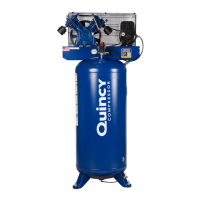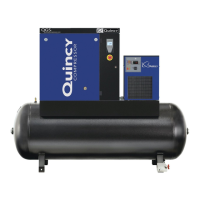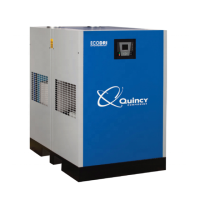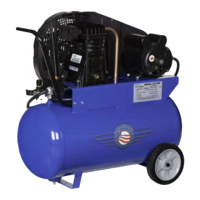Page 10
Low discharge pressure 1. Compressor too small for
application
1. Reduce air demand or use
a compressor with more air
capacity.
2. Air leaks 2. Listen for air leaks. Apply a
soap solution to all ttings and
connections. Bubbles will form
at points of leakage. Tighten or
replace ttings or connections.
3. Restricted intake air 3. Clean or replace air lter.
4. Blown gasket(s) 4. Replace necessary gaskets.
5. Broken or misaligned valves 5. Remove head and inspect for
broken or misaligned valves.
Replace valves, if necessary.
Install a new head gasket each time
head is removed.
Excessive noise “knocking”
1. Loose drive pulley or ywheel 1. Tighten drive pulley or ywheel
bolt.
2. Low on oil 2. Check for proper oil level. Low
or dirty oil may cause bearing
damage.
3. Worn connecting rod or connecting
rod bearing
3. Replace connecting rod and/or
connecting rod bearings.
4. Noisy check valve 4. Replace check valve.
Do not remove check valve with air
pressure in tank.
Excessive oil carryover
1. Worn piston rings 1. Replace with new piston rings.
2. Restricted intake air 2. Clean or replace air lter.
3. Too much oil in compressor 3. Drain oil to proper oil level.
4. Incorrect oil viscosity 4. Use a quality non-detergent SAE
40 (ISO 150) oil.
Water in tank and/or discharge
line
1. Normal amount of water will
increase as humidity in the air
increases.
1. Drain tank at least once per day.
2. Add an inline lter to reduce
moisture in the air line.
Will not run or motor hums
1. Low voltage 1. Check voltage with volt meter
across both legs of incoming
power. Check reset button on
motor.
2. Malfunctioning pressure switch 2. Repair or replace pressure switch.
3. Malfunctioning check valve 3. Replace check valve or pressure
switch.
Do not remove check valve with
air pressure in tank.
TROUBLESHOOTING GUIDE
CAUTION
DANGER
DANGER
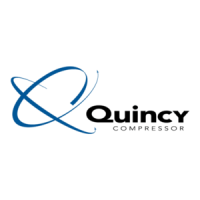
